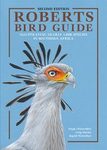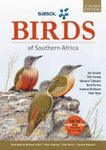Out of Print
By: Leo Zwarts(Author), Rob G Bijlsma(Author), Jan van der Kamp(Author), Eddy Wymenga(Author), Benoît Paepegaey(Translated by)
564 pages, colour photos, colour illustrations, colour maps
![Les Ailes du Sahel: Zones Humides et Oiseaux Migrateurs dans un Environnement en Mutation [Living on the Edge: Wetlands and Birds in a Changing Sahel] Les Ailes du Sahel: Zones Humides et Oiseaux Migrateurs dans un Environnement en Mutation [Living on the Edge: Wetlands and Birds in a Changing Sahel]]()
Click to have a closer look
About this book
Related titles
About this book
Language: French
Les Ailes du Sahel: Zones Humides et Oiseaux Migrateurs dans un Environnement en Mutation examines the function of the Sahel region of Africa as an important wintering area for long-distance migrant birds. It describes the challenges the birds have to cope with – climate change, of course, and rapid man-made habitat changes related to deforestation, irrigation and reclamation of wetlands. How have all these changes affected the birds, and have birds adapted to these changes? Can we explain the changing numbers of breeding birds in Europe by changes in the Sahel, or vice versa?
Summary in French:
Entre 1970 et 2005, pas moins de 59% des migrateurs transsahariens, soit 75 espèc es d’oiseau sur 127, ont subi un déclin. Les espèces qui hivernent dans les savanes et les zones humides sahéliennes sont celles qui ont le plus souffert. La zone sahélo-soudanienne est sans aucun doute une zone trouble: cet ouvrage nous explique pourquoi...
Parmi les 500 et quelques espèc es nichant en Europe pour un total de 1.300 à 2.600 millions de couples, environ un quart migre vers le sud jusqu’en Afrique sub-saharienne. Ces migrateurs passent l’essentiel de leur vie en Afrique et ne retournent vers le nord que pour nicher. Le système migratoire Paléarctique-Afrique draine des oiseaux provenant d’Europe, mais également d’Asie, jusqu’à la Sibérie orientale. Les migrateurs au long cours de cette vaste région, à l’exception de ceux qui hivernent en Asie du Sud, pénètrent en Afrique sub-saharienne. Ils ne s’y répartissent pas régulièrement, mais se concentrent principalement dans les savanes au nord de l’équateur, et évitent les forêts équatoriales.
Ces savanes sont sèches pendan t l’hiver boreal: les dernières pluies y tombent en septembre et octobre. Les conditions eviennent donc de plus en plus arides chaque jour, et ce n’est qu’après le dépar t de la plupart des oiseaux paléarctiques survivants, entre mars et mai, que les pluies reprennent. Ainsi, ce sont dans les régions tropicales au nord de l’équateur, là où la végétation est la plus esséchée, et où les espoirs de précipitations sont les plus faibles, que se rencontrent les plus fortes densités d’oiseaux paléarctiques.
Leur survie dépend de l’in tensité des précipitations pendant la courte saison des pluies, de l’ampleur des crues dans les zones inondables et de l’étendue de la végétation verdoyante. Ces facteurs peuvent être déterminants dans l’augmentation ou la diminution des populations. Les hordes d’oiseaux paléarctiques hivernant en Afrique sont principalement composées d’oiseaux d’eau et de passer eaux insectivores.
Customer Reviews
Out of Print
By: Leo Zwarts(Author), Rob G Bijlsma(Author), Jan van der Kamp(Author), Eddy Wymenga(Author), Benoît Paepegaey(Translated by)
564 pages, colour photos, colour illustrations, colour maps
"[...] There are extremely few recent works on African ornithology in French; the publisher is therefore to be congratulated for making this milestone for ecological studies in the region available to a Francophone public. [...]"
- Ron Demey, Bulletin of the African Bird Club 20(2), September 2013





![Les Ailes du Sahel: Zones Humides et Oiseaux Migrateurs dans un Environnement en Mutation [Living on the Edge: Wetlands and Birds in a Changing Sahel] Les Ailes du Sahel: Zones Humides et Oiseaux Migrateurs dans un Environnement en Mutation [Living on the Edge: Wetlands and Birds in a Changing Sahel]](http://mediacdn.nhbs.com/jackets/jackets_resizer_xlarge/21/210092.jpg?height=620)
![Les Ailes du Sahel: Zones Humides et Oiseaux Migrateurs dans un Environnement en Mutation [Living on the Edge: Wetlands and Birds in a Changing Sahel]](http://mediacdn.nhbs.com/jackets/jackets_resizer/21/210092.jpg)
![Les Ailes du Sahel: Zones Humides et Oiseaux Migrateurs dans un Environnement en Mutation [Living on the Edge: Wetlands and Birds in a Changing Sahel]](http://mediacdn.nhbs.com/jackets/jackets_resizer/21/210092_01.jpg)
![Les Ailes du Sahel: Zones Humides et Oiseaux Migrateurs dans un Environnement en Mutation [Living on the Edge: Wetlands and Birds in a Changing Sahel]](http://mediacdn.nhbs.com/jackets/jackets_resizer/21/210092_02.jpg)
![Les Ailes du Sahel: Zones Humides et Oiseaux Migrateurs dans un Environnement en Mutation [Living on the Edge: Wetlands and Birds in a Changing Sahel]](http://mediacdn.nhbs.com/jackets/jackets_resizer/21/210092_03.jpg)
![Les Ailes du Sahel: Zones Humides et Oiseaux Migrateurs dans un Environnement en Mutation [Living on the Edge: Wetlands and Birds in a Changing Sahel]](http://mediacdn.nhbs.com/jackets/jackets_resizer/21/210092_04.jpg)
![Les Ailes du Sahel: Zones Humides et Oiseaux Migrateurs dans un Environnement en Mutation [Living on the Edge: Wetlands and Birds in a Changing Sahel]](http://mediacdn.nhbs.com/jackets/jackets_resizer/21/210092_05.jpg)
![Les Ailes du Sahel: Zones Humides et Oiseaux Migrateurs dans un Environnement en Mutation [Living on the Edge: Wetlands and Birds in a Changing Sahel]](http://mediacdn.nhbs.com/jackets/jackets_resizer/21/210092_06.jpg)
![Les Ailes du Sahel: Zones Humides et Oiseaux Migrateurs dans un Environnement en Mutation [Living on the Edge: Wetlands and Birds in a Changing Sahel]](http://mediacdn.nhbs.com/jackets/jackets_resizer/21/210092_07.jpg)
![Les Ailes du Sahel: Zones Humides et Oiseaux Migrateurs dans un Environnement en Mutation [Living on the Edge: Wetlands and Birds in a Changing Sahel]](http://mediacdn.nhbs.com/jackets/jackets_resizer/21/210092_08.jpg)
![Les Ailes du Sahel: Zones Humides et Oiseaux Migrateurs dans un Environnement en Mutation [Living on the Edge: Wetlands and Birds in a Changing Sahel]](http://mediacdn.nhbs.com/jackets/jackets_resizer/21/210092_09.jpg)
![Les Ailes du Sahel: Zones Humides et Oiseaux Migrateurs dans un Environnement en Mutation [Living on the Edge: Wetlands and Birds in a Changing Sahel]](http://mediacdn.nhbs.com/jackets/jackets_resizer/21/210092_10.jpg)
![Les Ailes du Sahel: Zones Humides et Oiseaux Migrateurs dans un Environnement en Mutation [Living on the Edge: Wetlands and Birds in a Changing Sahel]](http://mediacdn.nhbs.com/jackets/jackets_resizer/21/210092_11.jpg)
![Les Ailes du Sahel: Zones Humides et Oiseaux Migrateurs dans un Environnement en Mutation [Living on the Edge: Wetlands and Birds in a Changing Sahel]](http://mediacdn.nhbs.com/jackets/jackets_resizer/21/210092_12.jpg)
![Les Ailes du Sahel: Zones Humides et Oiseaux Migrateurs dans un Environnement en Mutation [Living on the Edge: Wetlands and Birds in a Changing Sahel]](http://mediacdn.nhbs.com/jackets/jackets_resizer/21/210092_13.jpg)
![Les Ailes du Sahel: Zones Humides et Oiseaux Migrateurs dans un Environnement en Mutation [Living on the Edge: Wetlands and Birds in a Changing Sahel]](http://mediacdn.nhbs.com/jackets/jackets_resizer/21/210092_14.jpg)
![Les Ailes du Sahel: Zones Humides et Oiseaux Migrateurs dans un Environnement en Mutation [Living on the Edge: Wetlands and Birds in a Changing Sahel]](http://mediacdn.nhbs.com/jackets/jackets_resizer/21/210092_15.jpg)
![Les Ailes du Sahel: Zones Humides et Oiseaux Migrateurs dans un Environnement en Mutation [Living on the Edge: Wetlands and Birds in a Changing Sahel]](http://mediacdn.nhbs.com/jackets/jackets_resizer/21/210092_16.jpg)
![Les Ailes du Sahel: Zones Humides et Oiseaux Migrateurs dans un Environnement en Mutation [Living on the Edge: Wetlands and Birds in a Changing Sahel]](http://mediacdn.nhbs.com/jackets/jackets_resizer/21/210092_17.jpg)
![Les Ailes du Sahel: Zones Humides et Oiseaux Migrateurs dans un Environnement en Mutation [Living on the Edge: Wetlands and Birds in a Changing Sahel]](http://mediacdn.nhbs.com/jackets/jackets_resizer/21/210092_18.jpg)
![Les Ailes du Sahel: Zones Humides et Oiseaux Migrateurs dans un Environnement en Mutation [Living on the Edge: Wetlands and Birds in a Changing Sahel]](http://mediacdn.nhbs.com/jackets/jackets_resizer/21/210092_19.jpg)
![Les Ailes du Sahel: Zones Humides et Oiseaux Migrateurs dans un Environnement en Mutation [Living on the Edge: Wetlands and Birds in a Changing Sahel]](http://mediacdn.nhbs.com/jackets/jackets_resizer/21/210092_20.jpg)
![Les Ailes du Sahel: Zones Humides et Oiseaux Migrateurs dans un Environnement en Mutation [Living on the Edge: Wetlands and Birds in a Changing Sahel]](http://mediacdn.nhbs.com/jackets/jackets_resizer/21/210092_21.jpg)
![Les Ailes du Sahel: Zones Humides et Oiseaux Migrateurs dans un Environnement en Mutation [Living on the Edge: Wetlands and Birds in a Changing Sahel]](http://mediacdn.nhbs.com/jackets/jackets_resizer/21/210092_22.jpg)
![Les Ailes du Sahel: Zones Humides et Oiseaux Migrateurs dans un Environnement en Mutation [Living on the Edge: Wetlands and Birds in a Changing Sahel]](http://mediacdn.nhbs.com/jackets/jackets_resizer/21/210092_23.jpg)
![Les Ailes du Sahel: Zones Humides et Oiseaux Migrateurs dans un Environnement en Mutation [Living on the Edge: Wetlands and Birds in a Changing Sahel]](http://mediacdn.nhbs.com/jackets/jackets_resizer/21/210092_24.jpg)
![Les Ailes du Sahel: Zones Humides et Oiseaux Migrateurs dans un Environnement en Mutation [Living on the Edge: Wetlands and Birds in a Changing Sahel]](http://mediacdn.nhbs.com/jackets/jackets_resizer/21/210092_25.jpg)
![Les Ailes du Sahel: Zones Humides et Oiseaux Migrateurs dans un Environnement en Mutation [Living on the Edge: Wetlands and Birds in a Changing Sahel]](http://mediacdn.nhbs.com/jackets/jackets_resizer/21/210092_26.jpg)
![Les Ailes du Sahel: Zones Humides et Oiseaux Migrateurs dans un Environnement en Mutation [Living on the Edge: Wetlands and Birds in a Changing Sahel]](http://mediacdn.nhbs.com/jackets/jackets_resizer/21/210092_27.jpg)
![Les Ailes du Sahel: Zones Humides et Oiseaux Migrateurs dans un Environnement en Mutation [Living on the Edge: Wetlands and Birds in a Changing Sahel]](http://mediacdn.nhbs.com/jackets/jackets_resizer/21/210092_28.jpg)

















![Veldgids Diersporen Europa [Field Guide to Animal Tracks of Europe]](http://mediacdn.nhbs.com/jackets/jackets_resizer_medium/25/250295.jpg?height=150&width=101)


![Veldgids Vogeltrek in Beeld: Trekvogels Herkennen aan Hun Vliegbeeld [Field Guide to Bird Migration: Recognizing Migratory Birds by Their Silhouette]](http://mediacdn.nhbs.com/jackets/jackets_resizer_medium/26/263583.jpg?height=150&width=88)

![Veldgids Korstmossen [Field Guide to Lichens]](http://mediacdn.nhbs.com/jackets/jackets_resizer_medium/25/259434.jpg?height=150&width=101)


![Het Nachtvlinderboek: Macronachtvlinders van Nederland en België, Inclusief Rupsen [The Book of Moths: Nocturnal Macro-Moths of the Netherlands and Belgium, Including Caterpillars]](http://mediacdn.nhbs.com/jackets/jackets_resizer_medium/24/247580.jpg?height=150&width=113)

![Veldgids Hommels van Nederland en België [Field Guide to Bumblebees of the Netherlands and Belgium]](http://mediacdn.nhbs.com/jackets/jackets_resizer_medium/26/261396.jpg?height=150&width=101)